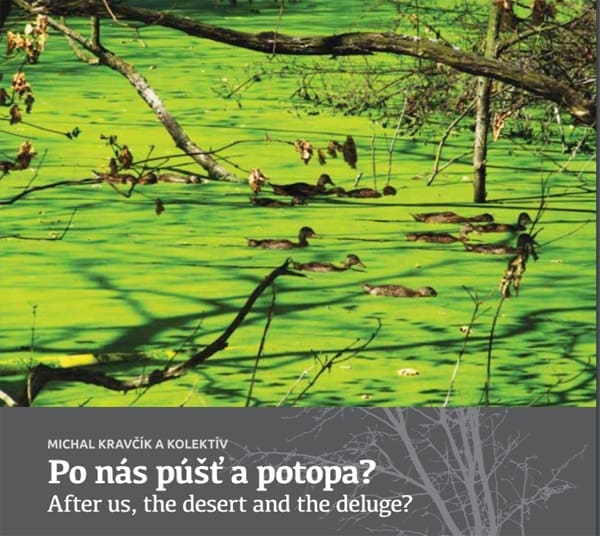Jan’s Quick Take:
This is a large and lavishly illustrated volume detailing the Slovakian “Landscape Revitalisation and Integrated River Basin Management Programme.” The book is presented in Slovakian and English languages (in side-by-side panels). This work is a unique reflection and photo-documentary, of sorts, of the insights and results from the Slovakian Program, while simultaneously delving into the science and conceptualizations behind the Blue Alternative / New Water Paradigm from a noticeably holistic and philosophical approach.
By Ing. Michal Kravčík,CSc. / Juraj Kohutiar / Michal Gažovič / Ing. Martin Kováč / Miroslav Hríb / Pavol Šuty / Dana Kravčíková
Download: After Us, The Desert and the Deluge
Excerpt from INTRODUCTION (p14)
Upsetting the balance of the hydrological cycle in the landscape caused by deforestation, and misunderstanding agricultural practices and urbanisation are even more serious than erosion.
Plato continues to describe the situation after deforestation: “Moreover, the land reaped the benefit of the annual rainfall, not as now losing the water which lows of the bare earth into the sea, but, having an abundant supply in all places, and receiving it into herself and treasuring it up in the close clay soil, it let of into the hollows the streams which it absorbed from the heights, providing everywhere abundant fountains and rivers…”(10)
The negative consequences of increased drainage of rainwater is a shortage of moisture in soil, reduction of the organic content of soil (and thus, reduction of its capability to retain water and fertility), desertification, on one hand, and floods on the other hand, a drop in underground water level, etc. Last but not least, the increased drainage of rainwater does not let enough water evaporate in the landscape and cool it down. Water deficit and overheated landscape result in the phenomena that the Russian researchers discussed: break- up of the water cycle over the landscape and increase of climate extremes. The optimalisation of the water cycle (but also the carbon and different other cycles) over the landscape is according to the mentioned scientists beyond the current knowledge and technical possibilities of humans. The idea to at least roughly o set the water deficit by saturating the small water cycle over the landscape by retaining rainwater by making it infiltrate the ground and evaporate as well as by increasing water supplies in the land, was one of the objectives of the Landscape Revitalisation and Integrated River Basin Management Programme for the Slovak Republic for 2010-2011.(11)
A healthy forest works to a large extent like a sponge – it is able to soak moisture during rainfall and then slowly release it, which results in moderating any differences between the periods of water excess and shortage. The Programme was directly triggered by exceptionally severe floods in 2010 and the municipalities prone to flash floods were preferentially involved in the Programme. Not only in our country politicians and experts are typically mobilised reactively take measures only after devastating flood events strike. That was also the case of the European Union after the floods in 2002. A group consisting of water management experts from the member states came up with an initiative that resulted in the brochure “Best practices on flood prevention, protection and mitigation”(12). It was used as one of the inspiration sources for the Slovak Landscape Revitalisation Programme. This document states that although there have always been floods, and they will be, any human intervention in the natural processes, such as changes in water drainage as a result of urbanisation, agricultural practices and deforestation, dramatically changes the situation in whole catchment areas and poses higher risks to flood-prone areas that are becoming more vulnerable. The fundamental principles of sustainable flood prevention, protection and mitigation start with stopping any human intervention in the natural processes as much as possible, its compensation and stopping any human intervention in the future.
The appropriate strategy on flood protection according to the above-mentioned document consists of the three-step approach: retaining, storing and draining rainwater. That means to make every effort to retain rainfall at the spot and also to store it there as long as possible. The final step is to let water drain to watercourses and it only concerns the water that is not able to be stored at the locality. Every cubic meter of water retained and not drained away immediately to growing watercourses takes away some of the burden in floods and contributes to the hydrological health of the locality. Whereas the typical water management practices in the last decades preferred the final step the Landscape Revitalisation Programme for the first time over a longer period focused on retention, particularly, in the area of upper river sections. The initial feedback on check dam cascades above frequently flooded municipalities is extraordinarily positive and raises hopes that after acquiring know-how the municipalities will implement similar measures even without any state funds. Despite that it should be emphasized that the objective of the Programme has never been to fully replace step one and step three by such retention measures.

